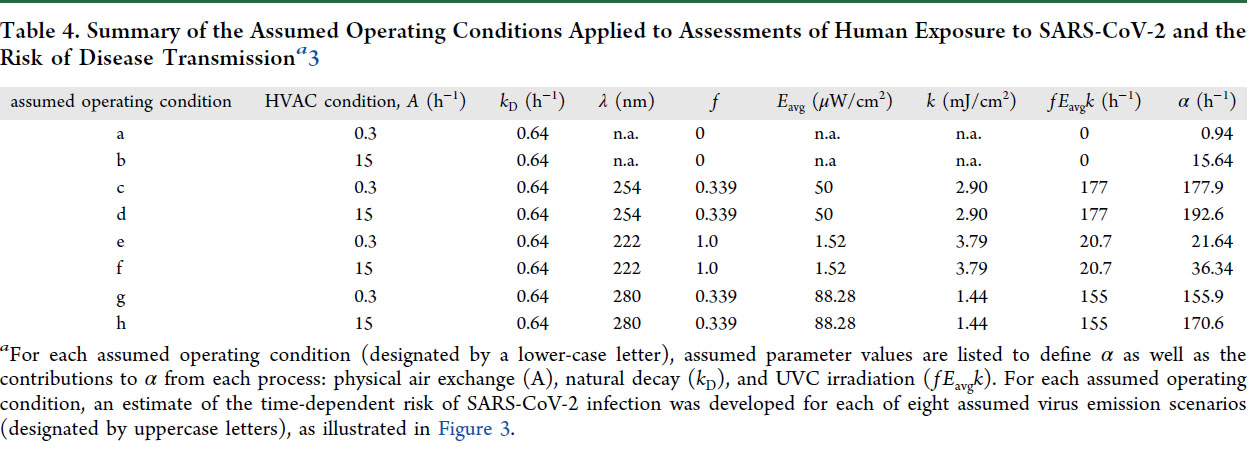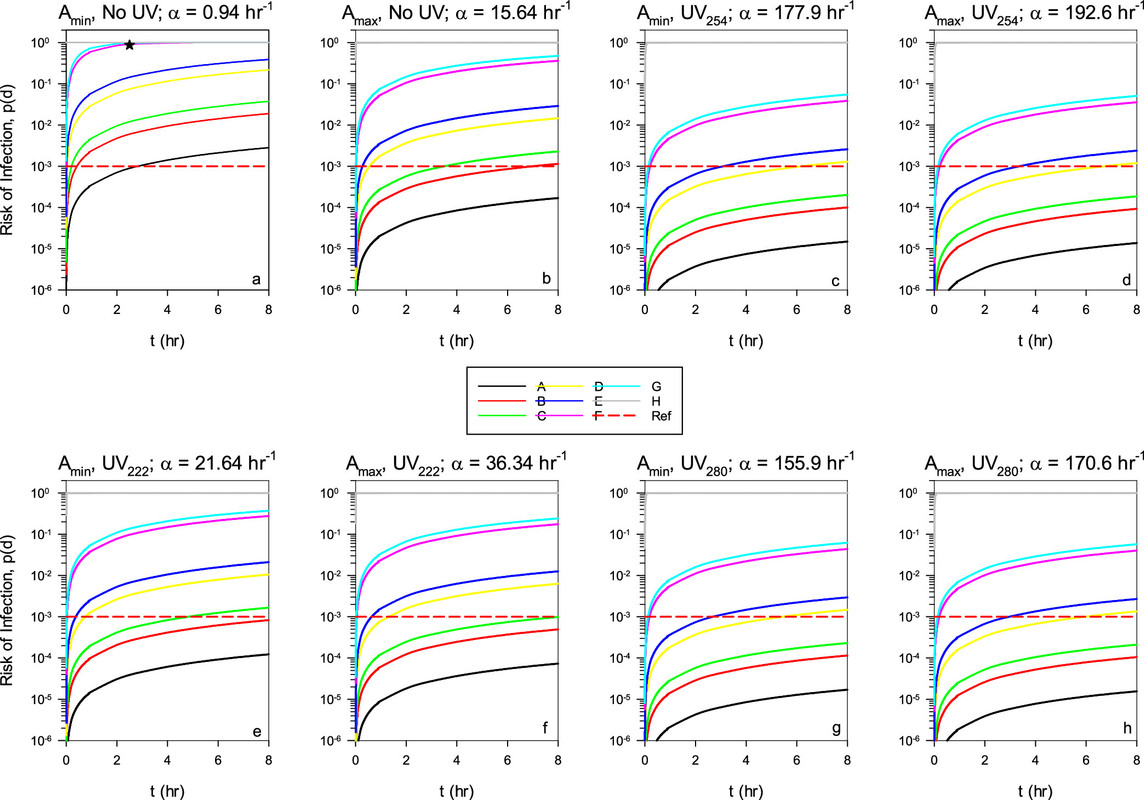Welcome to DU!
The truly grassroots left-of-center political community where regular people, not algorithms, drive the discussions and set the standards.
Join the community:
Create a free account
Support DU (and get rid of ads!):
Become a Star Member
Latest Breaking News
Editorials & Other Articles
General Discussion
The DU Lounge
All Forums
Issue Forums
Culture Forums
Alliance Forums
Region Forums
Support Forums
Help & Search
Science
Related: About this forumQuantification of the Effects of Ultraviolet Germicidal Irradiation on COVID-19 Transmission
The paper to which I'll refer briefly is this one: Quantitative Microbial Risk Assessment for Quantification of the Effects of Ultraviolet Germicidal Irradiation on COVID-19 Transmission Ernest R. Blatchley III and Haiying Cui Environmental Science & Technology 2023 57 (45), 17393-17403.
The Covid crisis has mostly subsided, but given population density, and the speed of evolution of retroviruses, this paper remains of value. This paper evaluates the effect of the wavelength and air turnover time for inactivating aerosol viral particles, thus reducing the risk of transmission.
From the introductory text of the paper:
COVID-19 is caused by severe acute respiratory syndrome coronavirus 2 (SARS-CoV-2), a novel β-coronavirus that shares genetic similarity with other coronaviruses that have caused disease outbreaks among humans, including SARS-CoV and MERS-CoV. (1) SARS-CoV-2 is a positive-sense single-stranded RNA virus, with a genome size of roughly 29.9 kb. (2) SARS-CoV-2 transmission is largely associated with aerosols that originate in the respiratory systems of infected individuals, although fomites may also contribute to transmission. (3)
Beyond COVID-19, it is likely that other disease outbreaks, epidemics, and pandemics will continue and perhaps become more prevalent in the future. (4) History suggests that these outbreaks are likely to be associated with airborne respiratory pathogens. As such, a clear need for the development of rational, predictable control measures against airborne pathogens has emerged...
...UV-C-based systems accomplish pathogen inactivation by inducing photochemical damage to critical biomolecules. Damage to nucleic acids is observed across the entire UV-C spectrum (200 nm ≤ λ ≤ 280 nm). For wavelengths less than about 240 nm, photochemical damage to proteins becomes an important contributor to pathogen inactivation. (7−9) For SARS-CoV-2, this behavior has been demonstrated by comparison of the inactivation action spectrum with the absorption spectrum for RNA extracted from the virus (see Figure SI-1). (10) In general, the wavelength dependence of SARS-CoV-2 inactivation by exposure to UV-C radiation follows the same shape as the RNA absorbance spectrum. However, for wavelengths less than about 240 nm, SARS-CoV-2 inactivation is greater than that predicted by the trend of RNA absorbance; this behavior is assumed to be attributable to protein damage. For applications that involve simultaneous exposure to UV-C radiation at 222 and 254 nm, a synergistic inactivation response has been reported that involves lipid peroxidation. (11)
Recent research has demonstrated the potential for new UVGI system configurations to be developed based on Far UV-C radiation, informally defined as radiation with wavelengths in the range 200 nm ≲ λ ≲ 230 nm. (12) The most common source of Far UV-C radiation for these applications is the optically filtered krypton chloride excimer (KrCl*) lamp, although solid-state Far UV-C devices are being developed. A typical output spectrum for an optically filtered KrCl* lamp is illustrated in Figure SI-2. Far UV-C radiation is strongly absorbed by proteins. Because of this, Far UV-C radiation has limited potential to penetrate the germinative cells of human skin or eyes, resulting in substantial reductions of the potential for damage to these tissues, relative to conventional UV-C radiation. In recognition of this behavior, the Threshold Limit Values (TLVs) for exposure to Far UV-C radiation have been substantially increased by the American Conference of Governmental Industrial Hygienists (ACGIH)...
Beyond COVID-19, it is likely that other disease outbreaks, epidemics, and pandemics will continue and perhaps become more prevalent in the future. (4) History suggests that these outbreaks are likely to be associated with airborne respiratory pathogens. As such, a clear need for the development of rational, predictable control measures against airborne pathogens has emerged...
...UV-C-based systems accomplish pathogen inactivation by inducing photochemical damage to critical biomolecules. Damage to nucleic acids is observed across the entire UV-C spectrum (200 nm ≤ λ ≤ 280 nm). For wavelengths less than about 240 nm, photochemical damage to proteins becomes an important contributor to pathogen inactivation. (7−9) For SARS-CoV-2, this behavior has been demonstrated by comparison of the inactivation action spectrum with the absorption spectrum for RNA extracted from the virus (see Figure SI-1). (10) In general, the wavelength dependence of SARS-CoV-2 inactivation by exposure to UV-C radiation follows the same shape as the RNA absorbance spectrum. However, for wavelengths less than about 240 nm, SARS-CoV-2 inactivation is greater than that predicted by the trend of RNA absorbance; this behavior is assumed to be attributable to protein damage. For applications that involve simultaneous exposure to UV-C radiation at 222 and 254 nm, a synergistic inactivation response has been reported that involves lipid peroxidation. (11)
Recent research has demonstrated the potential for new UVGI system configurations to be developed based on Far UV-C radiation, informally defined as radiation with wavelengths in the range 200 nm ≲ λ ≲ 230 nm. (12) The most common source of Far UV-C radiation for these applications is the optically filtered krypton chloride excimer (KrCl*) lamp, although solid-state Far UV-C devices are being developed. A typical output spectrum for an optically filtered KrCl* lamp is illustrated in Figure SI-2. Far UV-C radiation is strongly absorbed by proteins. Because of this, Far UV-C radiation has limited potential to penetrate the germinative cells of human skin or eyes, resulting in substantial reductions of the potential for damage to these tissues, relative to conventional UV-C radiation. In recognition of this behavior, the Threshold Limit Values (TLVs) for exposure to Far UV-C radiation have been substantially increased by the American Conference of Governmental Industrial Hygienists (ACGIH)...
The paper contains an interesting table showing the average number of viral particles generated by an infected individual engaged in various activities:

Table caption:
a Values of virus emission rate represent the median or mean of reported values for each activity type reported from the references listed.
To understand the final figure detailing risk, it is necessary to have access to this table:

Table caption:
a For each assumed operating condition (designated by a lower-case letter), assumed parameter values are listed to define α as well as the contributions to α from each process: physical air exchange (A), natural decay (kD), and UVC irradiation (fEavgk). For each assumed operating condition, an estimate of the time-dependent risk of SARS-CoV-2 infection was developed for each of eight assumed virus emission scenarios (designated by uppercase letters), as illustrated in Figure 3.
An evaluation of risk for various wavelengths and rates of turnover defined in the previous table, figure 3:

The caption:
Figure 3. Estimates of the risk of COVID-19 transmission in a 500 m3 room with a single infected individual as an emitter in the room; the emitter was assumed to be releasing aerosolized, infective viruses at rates that correspond with the conditions indicated by capital letters (see legend and Table 2). Conditions of operation of the HVAC and UVGI systems are indicated by lower-case letters (see the bottom right of each panel and Table 4). Horizontal dashed lines indicate a reference risk of 10–3, as suggested by Buonanno et al. (29) The terms Amin and Amax represent practical minimum and maximum values of physical air exchange, respectively, that are likely to be applied, based on guidance from ASHRAE (19) and CDC. (20) The black star in panel (a) indicates measured disease transmission from the Skagit Valley Chorale group Superspreader event.
Interesting I think.
For the record, I am trying to relate and to convince my son, the value of industrial scale radiation of air based Brayton cycles with high energy radiation, in the gamma range, x-rays to address aerosol organofluoride pollution. The heat in the Brayton cycle should also reduce the amount of second most important climate change driving gas, methane, by oxidizing it.
This is related to the work described here, but on an industrial scale far greater than what is described in this paper. This process would also destroy airborne viruses, for good and for bad.
I trust you're having a nice weekend.
1 replies
 = new reply since forum marked as read
Highlight:
NoneDon't highlight anything
5 newestHighlight 5 most recent replies
= new reply since forum marked as read
Highlight:
NoneDon't highlight anything
5 newestHighlight 5 most recent replies
Quantification of the Effects of Ultraviolet Germicidal Irradiation on COVID-19 Transmission (Original Post)
NNadir
Nov 2023
OP
Hermit-The-Prog
(36,631 posts)1. Blacklights and glowing posters are going to make a big comeback.